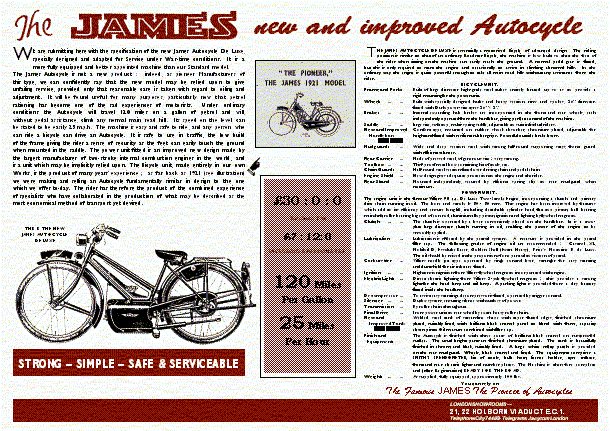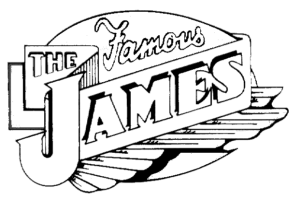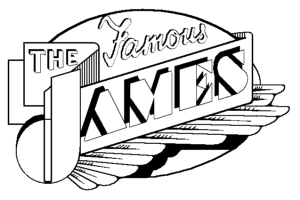 Go
to the Archive index
Go
to the Archive indexLast year, I had several enquiries about the specification of the James autocycles that were produced during the war years. At the time, I was not able to give complete answer, but I have recently managed to scrape together some more information on the wartime 'De Luxe' model.
The cycle parts are essentially the same as the pre-war 'Standard' model, having unsprung forks and finished in black enamel. The rear carrier uses the same pressing as the pre-war model but is mounted about 1½" further back - removing the need for the extra cross-piece that the pre-war one has. The front mudguard has a valence along its rear half. The licence disc holder is mounted on the front mudguard, behind the numberplate, but is not integral with the numberplate. Handlebars, controls and cranks are chromium plated, but all other parts, including the wheels, were enamelled black. The handlebars were resiliently mounted by having a rubber bush where they were clamped into the stem. Brake levers were the conventional sort, not the inverted levers of the pre-war model. The rearmost portion of the back mudguard-from the rear stay downward-was enamelled white as a "safety patch".
The fuel tank was the full-size, 11 pint, fluted one as fitted to post-war machines. This tank was chromium-plated, with the side panels painted black. It carried winged "The Famous James Autocycle De Luxe" transfers, again, the same as on post-war machines.
The engine was the Villiers Junior De Luxe, encased in small engine covers. The covers were black and had winged "James" transfers. A Smiths speedometer was fitted as standard equipment.

That's the specification, but, given the conditions prevailing in wartime, not all machines turned out that way.
Rubber was in short supply during the war and, because of this, many autocycles were supplied without a bulb horn. The speedometer was also dropped from the specification. The chromium plating on the fuel tank was another feature that disappeared, being replaced by "silver enamel". Evidence of surviving machines suggests that this silver enamelling had more of a golden tinge to it than the "Argenize" finish used after the war-although this could be cause by the paint yellowing over the intervening years. The fuel tap was changed for one without a reserve position.
There is contemporary documentary evidence for the variations that I have listed; it is also quite likely that there were other, undocumented, changes. Variations in the types of pedals & handlebar grips, and the amount of chromium plating would be the most likely areas for other changes.
Following my piece on the wartime model of James autocycle, I had a letter from Laurence Deakin. Laurence has a 1941 James, slightly earlier than the model I described in June's 'Buzzing'. The autocycle is finished in maroon: frame, fuel tank, mudguards and wheel rims; there is no sign of any chrome plating on any of these parts so it seems safe to assume that this is how it was when it left the factory. Laurence has owned the autocycle since 1954 and the machine has been partially dismantled since the early 70s. His enthusiasm has been revived and he hopes to get the James back on the road soon. However, the front wheel of the James is missing; if anyone can help with a replacement wheel, I'll put them in touch with Laurence.
I have had some more correspondence about the wartime autocycle, this time from Chris Bowden who says:
I was very interested to read about the wartime James autocycles. You may recall that last year I was seeking information on the restoration of my 1940 model. I have since found traces of the original paint on the tank to be a goldy-silver, not the Argenize silver of the later models. I also found the tank transfer to be "The Famous James" at the bottom of the tank, as with the earlier half-tank models, and not the "Famous James Autocycle" in the middle of the tank. My frame colour is black; it has sprung front forks and small engine covers. I'm still searching for a cover for the flywheel side. Other than this, I have completed the restoration and the bike was rallied all this season, along with my 1945 Norman autocycle.
'Taff the horns' has been in touch with more information on James's Argenise process. Argenise was largely used during the Korean war period from 1948 to 1953. Nickel had been made scarce and was a needed as a layer coat in chrome plating. Where possible, Argenize was used instead of chrome - for instance: the 'long tank' on the autocycles was chromium-plated when it was introduced, later models had an Argenised tank - the scarce nickel being saved for the parts that really had to be chromed. Some manufacturers attempted the chrome plating without a nickel coating, but the chrome would soon peel. Because of this, other makers had to introduce label to assure wary purchasers that the plating on their bikes was 'Nickel Secure'.
What transfers should the pre-war James autocycle have? Below are the outlines of two James badges:
 |
 |
The right-hand one is the correct one for the pre-war James autocycle. All my investigations so far show that James replaced the earlier 'scroll' badge with this one on both motor cycles and pedal cycles around 1933 or 1934. So, what is the one on the left? A modern transfer to this design is readily available but I have not managed to find any evidence at all of it ever being used by James. I would be grateful if any club member could tell me what it was applied to.
[Problem solved - the left hand badge above was used on the ML (Military Lightweight) model. Why redesign the badge for just this one model? It probably had to be done anyway - it is likely that existing stocks of transfers were destroyed when the James factory was bombed in WWII.]
Roy Best has sent me some detailed photographs of the frame and mudguards from a 1940 James autocycle. Although rusty, it is clear from the pictures that the bike carried lining - very fine double lines in red. My 1939 machine has no lining, so here we have another variation. Many thanks, Roy, for supplying another piece of the James jigsaw puzzle. If there are any James owners with a steady hand and a thin paintbrush who want to know where to put the lines, please get in touch.
In this column in August 1999, I mentioned that Laurence Deakin had a 1941 James autocycle finished in maroon. Alan Abrahams, who is the James marque specialist for the British Two-Stroke Club, found this item on the NACC web site and wrote to me about it. Alan believed that no James motor cycle was painted maroon before 1947 when James introduced a maroon and blue colour scheme on the ML model. The story was that these colours were introduced in recognition of the link between James and the airborne forces that were supplied with the James military motor cycles. However, both the frame and registration numbers on Laurence's machine confirm the 1941 date. So, we have yet another mystery surrounding James's wartime output. One theory was that the maroon was not an 'official' livery but a few autocycles were finished in that colour during the war because James happened to have some spare maroon enamel. Maroon was used on pre-war pedal cycles, so it is quite possible that James had some in stock.
Alan was able to clear up a couple of other queries: the 'serifed' version of the James transfer was used on just the ML model; all other models had the sans-serif version. And he also confirms that the gold colour of some of the Argenized parts is the effect of age, the factory brochures always refer to Argenize being an aluminium finish.
Alan has almost finished the construction of a web site covering all the post-war James models and is going to follow that up with a CD with even more James information. I hope to be able to give you details of these projects in a future edition.
Paul Morley, who is the James marque enthusiast of the Veteran-Cycle Club, wrote to me about the James marque notes in February's "Buzzing". Paul's opinion is that the theory that a war-time autocycle could have been enamelled in maroon to use up old stocks of pedal cycle enamel is feasible. He sent me a copy of an article from a 1915 edition of Motor Cycle and Cycle Trader, describing a visit to the James factory. This is the factory that was built in 1907 as a replacement for the old Sampson Road works, and remained in use until the Luftwaffe flattened it in 1940. The plan of the factory clearly shows that, although there were separate assembly areas for pedal cycles and motor cycles, they all passed through the same enamelling shop.
Although a huge areas of the factory was destroyed in the 1940 air raid, it had been rebuilt within the short space of three months. The bulk of James's effort at this time went into the production of shells; it's remarkable that any autocycles at all were produced in these conditions - making sure they were the right colour probably wasn't high in the list of priorities.